
Tesco PLC is a British multinational groceries and general merchandise retailer headquartered in Welwyn Garden City, England. In 2011 it was the third-largest retailer in the world measured by gross revenues and the ninth-largest in the world measured by revenues. It has shops in Ireland, the United Kingdom, the Czech Republic, Hungary and Slovakia. It is the market leader of groceries in the UK.
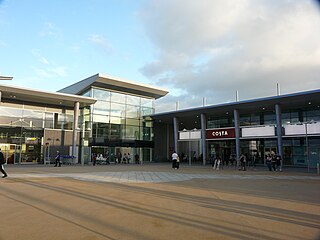
Bradley Stoke is a town in South Gloucestershire, England, situated 6 miles northeast of Bristol, It is near the Severn Estuary of the Bristol Channel, which is an extension of the North Atlantic Ocean, separating South Wales from South West England. Bradley Stoke is bordered by three motorways; the M5 to the north, the M4 to the east and the M32 to the south.
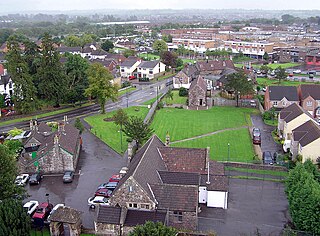
Yate is a town and civil parish in South Gloucestershire, England. It lies just to the southwest of the Cotswold Hills and is 12 miles northeast of Bristol city centre and 11 miles from the centre of Bath, with regular rail links to both cities.

Banksy is a pseudonymous England-based street artist, political activist and film director whose real name and identity remain unconfirmed and the subject of speculation. Active since the 1990s, his satirical street art and subversive epigrams combine dark humour with graffiti executed in a distinctive stenciling technique. His works of political and social commentary have appeared on streets, walls and bridges throughout the world. Banksy's work grew out of the Bristol underground scene, which involved collaborations between artists and musicians. Banksy says that he was inspired by 3D, a graffiti artist and founding member of the musical group Massive Attack.

Kingswood is a suburban town in South Gloucestershire, England, bordering the eastern edge of the City of Bristol. The suburb is situated 3.4 miles (5.5 km) east-northeast of Bristol city centre and 102 miles (164 km) west of London.

Patchway is a town in South Gloucestershire, England, situated 10 km (6.2 mi) north-north west of central Bristol. The town has become an overflow settlement for Bristol and is contiguous with Bristol's urban area, along with the nearby towns of Filton and Bradley Stoke.
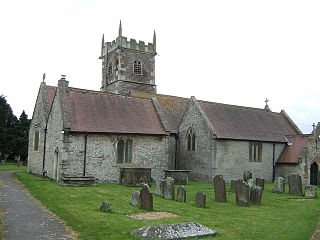
Stoke Gifford is a village and parish in South Gloucestershire, England, in the northern suburbs of Bristol. It had around 11,000 residents at the 2001 census, increasing to 15,494 at the 2011 census. It is home to Bristol Parkway station and Stoke Gifford depot, on the London-South Wales railway line, and the Bristol offices of Aviva which took over Friends Life in 2015, Hewlett Packard and the University of the West of England. The parish includes neighbouring Little Stoke, Harry Stoke and Stoke Park. The parish borders Filton, to the south-west, Patchway to the north west, Bradley Stoke to the north and Winterbourne and Hambrook to the east. To the south Stoke Gifford is served by the Bristol Ring Road, south of this a large green area known as the 'Green Lung' stretches to the inner city area of St Werburghs.
St Pauls is an inner suburb of Bristol, England, situated just northeast of the city centre and west of the M32. It is bounded by the A38, the B4051, the A4032 and the A4044, although the River Frome was traditionally the eastern boundary before the M32 was constructed. St Pauls was laid out in the early 18th century as one of Bristol's first suburbs.

Pontarddulais is both a community and a town in Swansea, Wales. It is 10 miles (16 km) northwest of the city centre. The Pontarddulais ward is part of the City and County of Swansea. Pontarddulais adjoins the village of Hendy in Carmarthenshire. The built-up population was 9,073.
The Bristol riots refer to a number of significant riots in the city of Bristol in England.

The Academy Cinema is a historic building on Cheltenham Road in the Stokes Croft area of Bristol, England. Since its construction in 1914, it has been used for many purposes. It is a Grade II listed building.

The Carriage Works are in Stokes Croft, Bristol, England.

Gloucester Road is a road in Bristol, England. It runs through the suburbs of St. Andrew's, Bishopston and Horfield and is a part of the A38, a former coaching route north of Bristol to Filton and the M5 Motorway.
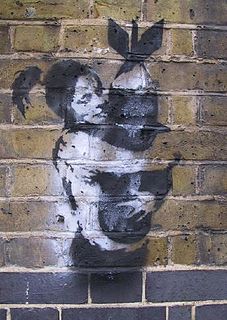
The Bristol underground scene was a cultural movement in Bristol beginning in the early 1980s. The scene was born out of a lack of mainstream clubs catering for the emergence of hip hop music, with street and underground parties a mainstay. Crews formed playing hip hop in disused venues with sound systems borrowed from the reggae scene: City Rockers, 2 Bad, 2 Tuff, KC Rock, UD4, FBI, Fresh 4, and The Wild Bunch were among them. These names were the precursors to the more well known names that came from this scene. It is characterized by musicians and graffiti artists. The scene was influenced by the city's multiculturalism, political activism, and the arts movements of punk, reggae, hip hop, hippies and new age.

Tottenham is a town in north London, England, within the London Borough of Haringey. It is located in the ceremonial county of Greater London and the historic county of Middlesex. Tottenham is centred 6 miles (10 km) north-northeast of Charing Cross, bordering Edmonton to the north, Walthamstow, across the River Lea, to the east, and Stamford Hill to the south, with Wood Green and Harringay to the west.

The People's Republic of Stokes Croft (PRSC) is a community organisation based in the Stokes Croft area of Bristol, England. It was launched 22 September 2007, by founding member and current chairman Chris Chalkley.

In early August 2011, England was struck by riots, the worst in the country in decades. The timeline of the events of the riots spanned from 6–10 August.
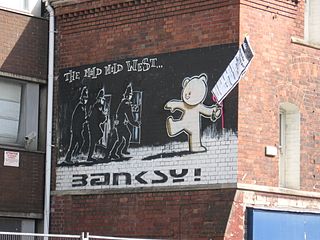
The Mild Mild West is a mural by graffiti artist Banksy, sited on No. 80 Stokes Croft, Bristol. It depicts a teddy bear throwing a Molotov cocktail at three riot police.

Westmoreland House was a building at Nos. 104–106 Stokes Croft, Bristol, next door to the Carriage Works.




















